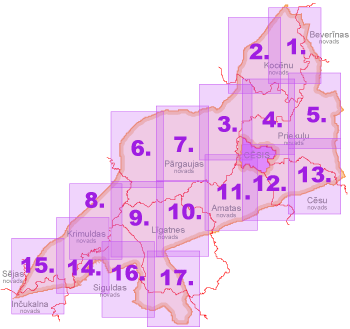Latvia's first and oldest national park, founded on 14 September 1973. It aims to protect the unique natural values of the Ancient Valley of river Gauja and its surroundings while at the same time providing both recreational and nature protection functions in the area. Several particularly biologically valuable areas have been distributed: Nurmies Hollow, Rochs Forest, Inciem Sennok and Suda bog reserves Area s. On the banks of Gauja and its tributaries, the devon sandstone outcrops, which are mostly geomorphological monuments of nature, are particularly representative. Highly rich flora and fauna: more than 800 species of vascular plants have been identified, 149 bird species, 48 mammalian species, etc. values. Several lakes have rare oligotrophic lake plants with dortmaine lobliness, ezerens and egalvitis m. The park also aims to promote natural tourism and the sustainable development of the area.
The most important part of Gauja National Park (GNP) and the main dominant – the Ancient Valley of river Gauja – are both protected and usable environmental and cultural statements for tourism and healthy recreation. GNP area is 91786 ha and its territory is divided into 5 functional zone s. The area of the park contains areas in which all natural resources are completely excluded from economic and other activities. They are a nature reserve area s. Nature reserves occupy a small but particularly valuable part of Park, their attendance is not allowed. The rest of the Park area only allows economic activity that does not significantly alter the historical landscape structure.
Forests occupy 47% of the Park area. Since 2004, the GNP has been part of the NATURA 2000 network as an area designated for the protection of specially protected species and habitats I. The history of tourism in the GNP area has long traditions. First visitors with a walking stick along Sigulda's neighborhood trails had been walking in the 19 th century. Every year thousands of visitors are attracted by the strange landscape, the largest outcrops of devon rock in Latvia – sandstone precipice, cliffs and caves, as well as cultural and historical treasures covered by legends and stories.
GNP has more than 500 cultural and historical monuments – castel mounds, castles, churches, manors, watermills and windmills, as well as other archaeological, architectural and artistic monuments.
Water tourist camps on the banks of Gauja, Amata and Brasla, several motorist camps are designed for motorists, walking paths more than 100 kilometres in length, while tourists travel throughout the territory of Gauja National Park. GNP is in constant development. New Natural Education Centres have been set up, tourism facilities are being developed. In the natural paths of Ligatna, visitors can watch forest dwellers from reconstructed viewing platforms and watch the Old River of Gauja from and the tower of views.




